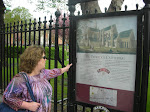Inclusion is wonderful. Inclusion is for good for teachers, businesses, students, classrooms, and communities. Across the country public schools have focused on Adequate Yearly Progress or AYP, which is measurement of individual student learning. AYP compares a student's academic scores year to year using standardized testing. AYP has confirmed concerns that some students were not learning. We are spending money on practices that make students dependent on others, are very costly, and frequently don't produce results. What does work, is doing the right thing, which is exactly what we saw in the video.
Watching the video of Celeste's class it was clear that she was part of the class; she was accepted and included as a different “bodied student.” Yes, she is a functioning student within her class that was isolated from her peers by illness. It is so amazing that we have the capabilities to bring those individuals that are removed by illness, geography, or even anxiety from a classroom and have them become part of the classroom community. I found that truly inspiring! How could anyone question the decision to provide her instruction using Skype?
The use of Assistive Technology (AT) has been increasing but it is a mutual commitment that requires both teacher and student to be active participants. There is a National Public website on AT listing of over 22,000 AT products with searches by function or activity. The University of New Hampshire Institute on Disability is a leader in the AT movement offering classes and workshops on a variety of AT devices and strategies. One upcoming class is titled, Universally Designed Technology to Support Reading, Writing, and Communication in the General Education Classroom. Most devices are really one time purchases and are more cost effective than the use of paraprofessionals or aids.
My ten years teaching in a large high school (2200+students) provided the opportunity to teach two students, Beverly and Nancy using AT. Both students had full mental function. Beverly was born legally blind, attending general education class only at the high school level. At age ten, Nancy was in an accident that left her only able to move her head. Beverly loved the general education courses and found AT provided many more options including independence for her in high school. I was very comfortable with both students technology but was surprised by the lack of support for the teacher. Teachers supporting students with AT receiving no extra training and must provide all student modifications without any extra time or reduction in schedule. The class sizes are not reduced for AT students and after school makeup sessions may not be reasonable for the student to attend. When considering significance disabilities shouldn't plans require the case manager review in detail the student's Individual Education Plan (IEP) and provide examples of prior modifications? A team type approach to make sure the student gets the best possible education with appropriate modifications.

No comments:
Post a Comment